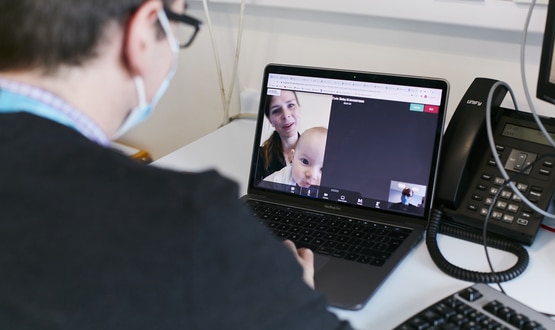Dr Gordon Hay, service director of A&E/urgent care services at Moorfields Eye Hospital discusses the challenge to minimising hospital visits during the pandemic and how Moorfields Eye Hospital utilised a video conference platform to implement a fully functional virtual A&E service, providing an effective hybrid care delivery model for the future.
At the outset of the pandemic at Moorfields Eye Hospital, we were faced with two immediate challenges; identify and manage the most critical emergencies and minimise hospital visits while providing continuity of care for our patients. In worst-case scenarios, a lack of access to these essential services could have led to the patient suffering significant harm or loss of vision. Additionally, lockdown restrictions on face-to-face appointments resulted in reduced access for lower-risk patients to their local eye unit, which in turn put extra demand on our emergency team. The response has upheld award-winning patient safety levels and provided an effective model for a longer-term shift to hybrid care delivery.
In response to the sudden change in how care had to be delivered, we implemented a fully operational virtual A&E service just three days after the UK entered lockdown. Using the Induction Attend Anywhere platform, it provided accessible, one-click A&E clinics that were fully configurable to the hospital environment. We could in turn provide patients with a secure, easy-to-use service, with superior safety levels, throughout the pandemic.
Offering a remote service enabled our patients to have appointments with ophthalmologists who could also deliver their care while self-isolating or shielding. To date, over 45,000 video consultations have taken place – over 30,000 of these with a clinician in A&E – with around an additional 45,000 interactions with receptionists and support staff. This accounts for 18,000 hours of interactions undertaken by over 370 staff members.
Highlighting the positives
We published a study in the peer-reviewed journal, eClinicalMedicine, which highlighted the positive impact of the virtual A&E service and explored its safety compared to in-person triages in emergency ophthalmology. Our research found that the virtual A&E service delivers patient safety levels comparable to an in-person triage. 78% of our patients have been able to get the treatment they need without travelling into Moorfields Eye Hospital, with 95% of patients giving the service they received a maximum rating of five stars. Patients were able to avoid lengthy waits in A&E and receive reassurance from an experienced ophthalmologist within minutes without having to visit the hospital.
Underpinning the project was a commitment to learning and delivering the best possible patient experience. This didn’t just stop when the platform was rolled out, it was boosted by smart surveys which provided real-time data collection straight after appointments to measure success and identify areas for improvement. Scaling this across other hospitals and teams within Moorfields has facilitated quicker access to specialist consultants for patients across the country and delivered significant cash-release savings for the NHS.
At Moorfields, we have also used our experience to contribute towards the production of the National Clinical Safety Report template for the platform; taking part in regional and national webinars describing how the technology was implemented and is used.
As we move to a post pandemic world, today around 25% of A&E consultations are virtual. What started as an emergency response solution has evolved into a long-term hybrid care delivery model that prioritises patient safety at its core.

